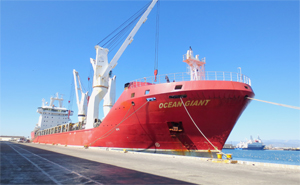Preparing the privately owned U.S.-flag cargo fleet to support long-term military operations could require 1,800 more licensed mariners and increased vessel subsidies, according to a new report from the Government Accountability Office (GAO).
The Department of Defense (DOT) and Maritime Administration (MarAd) have shared concerns for years about the sustainability of the U.S.-flag fleet. Overall, the number of large U.S.-flag vessels engaged in international trade has declined about 60 percent in less than 30 years, from approximately 199 vessels at the end of 1990 to 81 in February 2018.
In 2014, Congress directed the DOT to develop two national strategies to keep the U.S.-flag fleet sustainable and ensure the long-term viability of U.S.-flag vessels and U.S.-citizen mariners. The authors of the GAO report said the DOT developed a combined draft strategy under the Obama administration, but it is now undergoing a review by the Trump administration.
In light of its findings, the GAO recommended that the DOT complete the national maritime strategy and establish time frames for its issuance.
“Without establishing a timeline to complete this required strategy, DOT continues to delay providing decision-makers the information they need to determine how best to address the challenges facing the U.S.-flag fleet,” the report said.
Currently, the U.S. government financially supports U.S.-flag vessels in international trade by providing an annual stipend for ships through the DOT’s Maritime Security Program (MSP), and by requiring that certain types and percentages of government cargo be transported on U.S.-flag vessels.
The MSP pays an annual stipend to offset the additional $6.5 million that vessel owners pay to operate under the U.S. flag, up from $4.8 million in 2009, according to MarAd. Currently, 60 vessels are enrolled in the MSP and receive the stipend. Congress raised the stipend amount from $3.5 million per vessel for fiscal year 2016 to $4.9 million per vessel for fiscal year 2017, which has temporarily stabilized the financial situation of MSP operators.
“However, MarAd officials stated trends in operating costs and government cargo suggest this will remain an ongoing challenge,” the GAO said.
Additional costs for U.S.-flag operations include retirement benefits for union employees and requirements to have vessel maintenance done at U.S. shipyards. Work done at foreign yards is subject to a 50 percent ad valorem tax.
Many vessel owners count on U.S. government cargo to make up the gap between the MSP stipend and the actual cost of operations. The amount of government cargo shipped under cargo preference requirements has decreased due to the diminished U.S. military presence around the world and falling volumes of government food aid, as well as the higher cost of shipping on U.S.-flag vessels. Aid agencies say the higher cost of transportation reduces the amount of food assistance they are able to provide.
Vessel operators told MarAd in 2015 that rising costs and declining government cargoes were the main reasons they reflagged or retired vessels.
The DOT strategy is expected to address the concern that there may not be enough U.S.-citizen sailors to crew ships during a long-term military action. A MarAd working group recently estimated a shortage of more than 1,800 mariners in the event of sustained military action, while current crew levels could support an initial surge.
The GAO recommended data improvements to increase the accuracy of the count of available mariners. For instance, the U.S. Coast Guard database lists 15,000 mariners with unlimited credentials who are not employed on large oceangoing vessels in either private or government positions.

